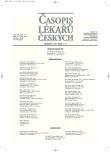Prevention of Thrombembolic Disease in Internal Medicine
Authors:
D. Karetová; M. Chochola; A. Linhart
Authors‘ workplace:
II. interní klinika kardiologie a angiologie 1. LF UK a VFN, Praha
Published in:
Čas. Lék. čes. 2006; 145: 353-357
Category:
Review Article
Overview
Although deep vein thrombosis is often considered to be associated with recent surgery, 50-70% of symptomatic thrombembolic events occur in nonsurgical patients. Hospitalization for acute medical illness is independently associated with about eightfold increase in relative risk for venous thrombosis. Thus correct evaluation of risks for thrombembolic disease in individual inpatient and appropriate prophylaxis offers the opportunity to improve the prognosis of acutely ill patient. The most efficient and easy way of pharmacologic prophylaxis is subcutaneous administration of low molecular weight heparin. Only in minority of patients mechanical methods of prevention are sufficient. The optimal duration of thromboprohylaxis in medical patients is unknown and we have to evaluate the changing conditions in each patient.
Key words:
internal diseases, thrombembolic disease, prevention, low molecular weight heparins.
Labels
Addictology Allergology and clinical immunology Angiology Audiology Clinical biochemistry Dermatology & STDs Paediatric gastroenterology Paediatric surgery Paediatric cardiology Paediatric neurology Paediatric ENT Paediatric psychiatry Paediatric rheumatology Diabetology Pharmacy Vascular surgery Pain management Dental HygienistArticle was published in
Journal of Czech Physicians

Most read in this issue
- Buerger’s Disease
- Vascular Involvement in Thoracic Outlet Syndrome
- Superior Vena Cava Syndrome – Potential of the Intervention Therapy
- NGAL-Neutrophil Gelatinase Associated Lipocalin in Biochemistry, Physiology and Clinical Praxis
